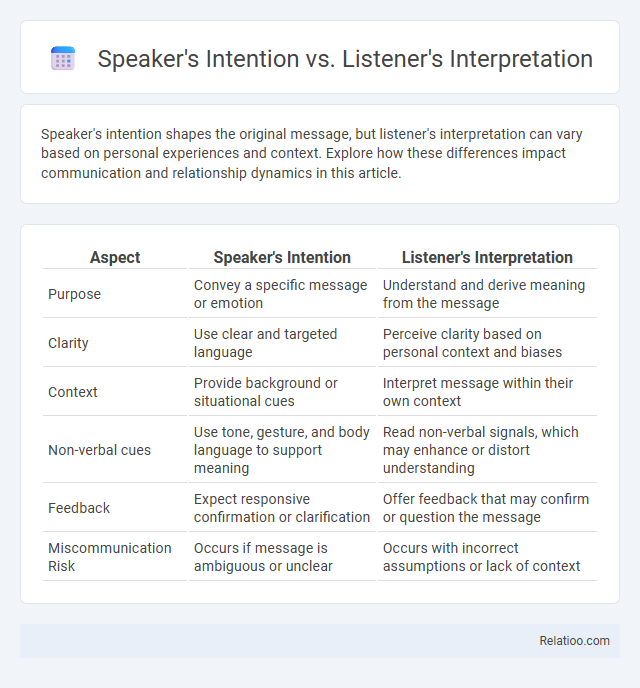Speaker's intention shapes the original message, but listener's interpretation can vary based on personal experiences and context. Explore how these differences impact communication and relationship dynamics in this article.
Table of Comparison
| Aspect | Speaker's Intention | Listener's Interpretation |
|---|---|---|
| Purpose | Convey a specific message or emotion | Understand and derive meaning from the message |
| Clarity | Use clear and targeted language | Perceive clarity based on personal context and biases |
| Context | Provide background or situational cues | Interpret message within their own context |
| Non-verbal cues | Use tone, gesture, and body language to support meaning | Read non-verbal signals, which may enhance or distort understanding |
| Feedback | Expect responsive confirmation or clarification | Offer feedback that may confirm or question the message |
| Miscommunication Risk | Occurs if message is ambiguous or unclear | Occurs with incorrect assumptions or lack of context |
Understanding Speaker’s Intention
Understanding Speaker's Intention is crucial for effective communication, as it reveals the true purpose behind the message conveyed. Misinterpretations arise when Listener's Interpretation deviates from the Speaker's intention, leading to misunderstandings and communication breakdowns. You can enhance communication by actively seeking clarification and considering context to align your understanding with the speaker's intended meaning.
The Role of Context in Communication
The role of context in communication is crucial for aligning the speaker's intention with the listener's interpretation, as it shapes the meaning behind words and gestures. Your understanding hinges on contextual cues, such as cultural background, situational factors, and prior knowledge, which guide accurate interpretation beyond literal language. Miscommunication often arises when context is ignored or misread, emphasizing its pivotal role in achieving shared meaning between speaker and listener.
How Listeners Interpret Messages
Listeners interpret messages by decoding verbal and nonverbal cues based on their personal experiences, cultural background, and contextual understanding. This interpretation process can lead to variations where the listener's perceived meaning differs from the speaker's original intention due to ambiguity or differing frames of reference. Effective communication requires aligning speaker intention with listener interpretation through feedback and clarification strategies.
Common Causes of Miscommunication
Miscommunication often arises when the speaker's intention does not align with the listener's interpretation, resulting in misunderstandings that hinder effective communication. Factors such as ambiguous language, cultural differences, and assumptions can distort the intended message, leading to confusion between parties. Understanding these common causes helps you tailor your communication to ensure clarity and minimize interpretation gaps.
Influence of Culture on Interpretation
Cultural background profoundly shapes the listener's interpretation of a speaker's intention, often leading to varying understandings despite identical messages. You must recognize that meanings embedded in speech acts, gestures, and context can differ significantly across cultures, influencing communication outcomes. Misinterpretations frequently arise when the speaker's intended message clashes with the listener's culturally informed perceptions, highlighting the crucial role of cultural awareness in effective communication.
The Impact of Tone and Nonverbal Cues
Speaker's intention often conveys the intended meaning through tone and nonverbal cues, which profoundly influence how messages are received. Listener's interpretation depends on perceiving vocal inflections, facial expressions, and gestures to decode the true sentiment behind words. Your understanding of communication improves when you recognize mismatches between intention and interpretation caused by subtle differences in tone and body language.
Barriers to Accurate Understanding
Barriers to accurate understanding arise when discrepancies occur between a speaker's intention and a listener's interpretation, often caused by ambiguous language, cultural differences, or varying contextual knowledge. Misinterpretations increase with the presence of nonverbal cues misaligning with verbal messages or when assumptions override clarifications. Effective communication requires bridging these gaps through active listening, feedback mechanisms, and shared semantic frameworks to minimize barriers.
Strategies for Clearer Intent Expression
Effective communication requires aligning the speaker's intention with the listener's interpretation through deliberate strategies such as using explicit language, providing contextual cues, and verifying understanding. Techniques like paraphrasing, asking clarifying questions, and employing non-verbal signals enhance clarity and reduce misinterpretation. Implementing these methods facilitates clearer intent expression, improving overall message accuracy and minimizing communication breakdowns.
Improving Listener Comprehension Skills
Speaker's intention defines the original message or purpose behind an utterance, while listener's interpretation involves decoding and understanding that message within context. Improving listener comprehension skills requires actively focusing on the speaker's tone, non-verbal cues, and contextual background to align interpretation with intention. Training in active listening, critical thinking, and feedback techniques significantly enhances the accuracy of understanding spoken communication.
Bridging the Gap Between Intention and Interpretation
Speaker's intention often shapes the meaning conveyed, yet listener's interpretation can diverge due to contextual, cultural, or linguistic factors. Bridging the gap between intention and interpretation requires enhancing pragmatic competence, employing clear, contextually grounded communication strategies, and fostering active listening skills. Neuroscientific and linguistic research highlights the role of theory of mind and shared knowledge in aligning speaker intent with listener understanding, reducing miscommunication.

Infographic: Speaker's Intention vs Listener's Interpretation
 relatioo.com
relatioo.com